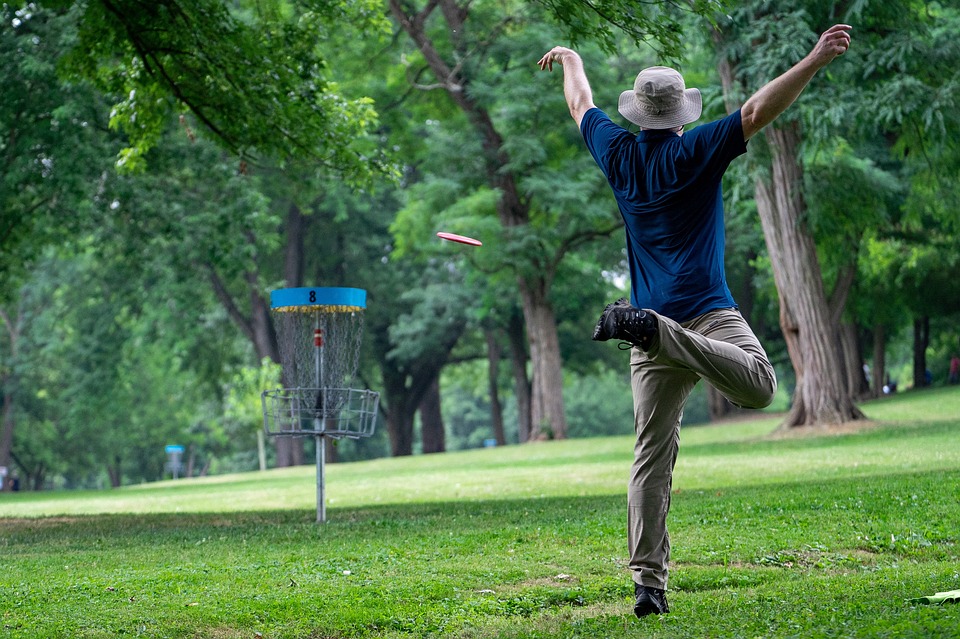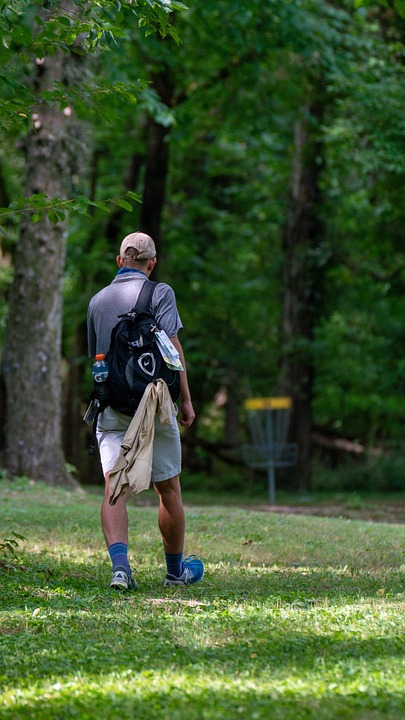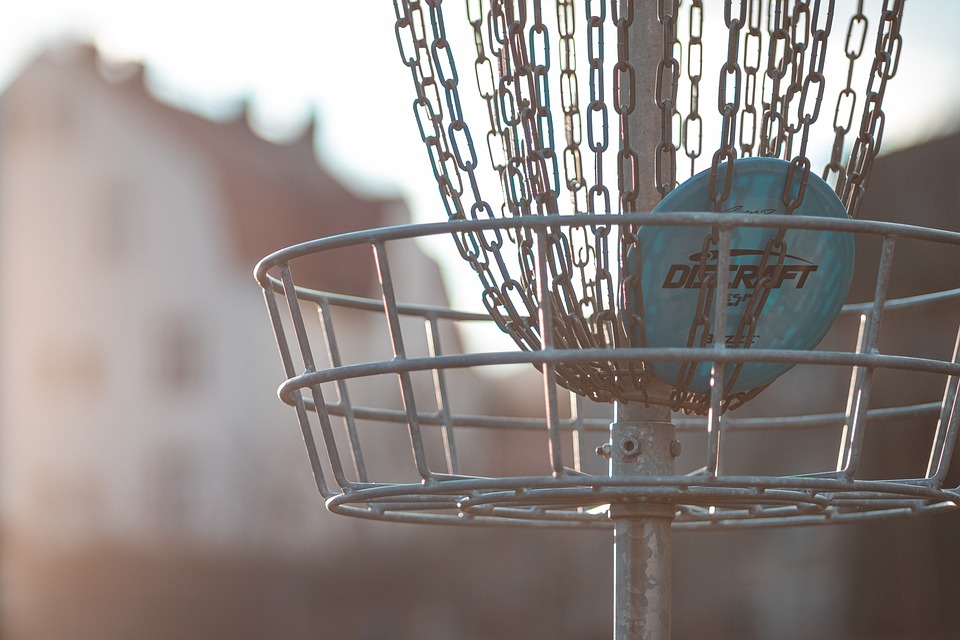The Rise of the $10 Million Disc Golf Celebrity
When Paul McBeth first started playing in professional disc golf tournaments, he’d crisscross California in his father’s 1978 Dodge Ramcharger. His dad had mostly used it to rock-crawl in the desert outskirts of Los Angeles. The top of the SUV was sawed off and the side windows were smashed out. The doors were so dented they looked like topographic maps. The windshield was scarred, and the gas pedal was missing. When storm clouds gathered, Paul kicked a metal bar to the floor as he tried to outrun the rain.
His next few cars weren’t much nicer. When he was 19, he found out a friend was planning to dump an Infiniti I30 in the scrapyard and offered to pay him $500 for it. McBeth drove it from L.A. to Kansas City for the 2009 Professional Disc Golf Association (PDGA) world championships and almost all the way back. It blew a gasket 30 minutes from his house. Then there was his Ford Thunderbird that overheated every half-hour on the highway, and his camper van that he thought would save him money on hotels but ended up costing him at the gas pump.
Finally, in 2011, after winning $4,000 for taking first place at the Memorial Championship in Scottsdale, Arizona, McBeth had saved enough money to buy a new car. He wanted a Jeep Patriot. The problem was the paperwork. “Under occupation, I put ‘professional athlete,’” McBeth says. “I guess they didn’t believe me because they wouldn’t let me finance it. I ended up having to buy the car with cash.”
In the decade since, McBeth’s disc golf career has soared. He’s won the PDGA world championship five times and the United States Disc Golf championship twice. In 2010, the PDGA championship’s total purse was $33,782; at this week’s event, the men’s winnings are expected to be upward of $150,000. McBeth has earned more than half a million dollars from his performances. He is, undoubtedly, the most accomplished disc golfer in the world.
But except to a subset of hardcore frisbee fans, his more impressive accomplishments have come away from the course. In February, disc golf manufacturer Discraft announced it had extended McBeth’s endorsement deal to a guaranteed $10 million over 10 years. McBeth also has sponsors for other disc golf gear, such as grip equipment and bags, and owns part of a company called Foundation Disc Golf that produces both products and content. He has deals outside of disc golf equipment too, with the likes of Adidas and Celsius energy drink. According to 2019 data from the athlete marketing platform Opendorse, only about 70 athletes in the world make at least a million dollars a year in endorsement deals. McBeth’s endorsement income from Discraft alone puts him on par with Bears linebacker Khalil Mack, Jazz guard Mike Conley Jr., and Astros pitcher Justin Verlander.
McBeth has carved out a lucrative career in a niche sport, in part as an athlete and in part as an influencer. He isn’t alone in using this blueprint. Competitors in sports ranging from bowling to lacrosse have been able to amass riches by building their brands—and growing the games they love along the way.
“I think about it as a three-step funnel,” says Li Jin, the founder of the digital marketing platform Atelier Ventures who coined the term “Passion Economy” to describe how influencers monetize social media. The first step is to attract a big audience on a known platform, like Instagram or Twitter. The second is to bring them to a platform the influencer owns, such as a newsletter or podcast. The final step is to turn people into paying customers. “That,” she says, “is how influencers turn social capital into financial capital.”
McBeth agreed to that $10 million deal in July 2020 after hosting a paintball party for his 30th birthday. A couple of months later, he signed the paperwork at Discraft’s headquarters in Michigan. In November, he shared a series of stories with his 150,000-plus Instagram followers. The first showed a trailer from a car dealership in Michigan. The second and third showed glamorous shots of his latest car purchase: a McLaren 570S Spider. The luxury convertible—which starts at more than $200,000—has switchblade doors and a retractable roof.
Even in a niche sport, it’s good to be the GOAT.
By now you may have started browsing for disc golf gear in another tab. But before you complete your order, you first need to figure out how to get anyone’s attention. Not long ago, niche sports cracked the national consciousness only as punch lines. In a now-iconic Seinfeld episode, George Costanza gets a severance package from the Yankees—enough to sustain him for an entire summer—and tells Jerry he’s going to learn to play frolf.
“You mean golf?” Jerry asks.
“Frisbee golf, Jerry,” George responds. “Golf with a frisbee!”
In the 2004 comedy Dodgeball, Vince Vaughn’s group of misfits face off against Ben Stiller’s crew of hulking weightlifters on a fictional channel called ESPN 8: The Ocho. The parody network became such a cultural phenomenon that in 2017 ESPN launched an annual “Ocho TV” day, featuring events like the National Stone Skipping Competition and World Sign Spinning Championship. (How sign spinning became an international competition before stone skipping is a mystery best explored in a separate story.) But those so-called joke sports have had the last laugh. From 2017 to 2019, ESPN’s the Ocho ratings climbed year over year. Last May, a deadlift world record attempt drew more than 300,000 viewers—the network’s most-watched program of the day.
For many niche sports, television is still seen as the ultimate status symbol. Some leagues have gone so far as to buy air time for their biggest events. Last year, Dynamic Discs paid the CBS Sports Network “in excess of six figures” to broadcast their disc golf tournament. This stands in contrast to networks’ relationships with the more prominent sports leagues. In March, the NFL secured $113 billion from its television partners for the rights to air football games over the next 11 years.
But television isn’t the only way to command mass attention. For smaller sports and their stars, social media provides access to massive audiences without traditional gatekeepers. “To millions of kids, TikTok and YouTube are mainstream entertainment. They don’t watch TV,” says Taylor Lorenz, who covers social media, Gen Z, and influencers for The New York Times. “Sometimes you need to get onto TV to get credibility with boomer CEOs. But for individuals, you can often monetize better on your social media.”
The surest path to profitability is to go viral. And the kings of the viral clip are the dudes from Dude Perfect. What began as a series of stunts by college roommates at Texas A&M has turned into the most popular sports channel on YouTube. Dude Perfect has nearly twice as many subscribers (56 million) as four major U.S. sports leagues—the NBA (16.7 million), NFL (7.8 million), MLB (3.0 million), and NHL (1.6 million)—combined. Its water bottle flips and ping-pong tricks have reshaped what constitutes athletic accomplishment online. And its influence echoes across the niche sports landscape. (The dudes declined to be interviewed for this story.)
McBeth is friends and business partners with Brodie Smith, a former ultimate player who became internet famous for his frisbee trick shots and has collaborated on three videos with Dude Perfect. Smith, who boasts more than 2 million YouTube subscribers and almost a million Instagram and Twitter followers, instantly became the world’s most famous disc golf player when he turned pro in late 2019. Smith has documented his journey into the sport, and has learned the finer points of the game from McBeth. In exchange, Smith has schooled McBeth on the finer points of internet fame. “Brodie has made everyone in disc golf up their YouTube game,” McBeth says. “He’s inspired me a lot. We used to try to find the time to post videos when we could. Now we make the time. It’s become a priority.”
Jason Belmonte, the most accomplished professional bowler in the world, has collaborated on two videos with Dude Perfect. The first—which shows him whizzing bowling balls past the dudes’ heads and breaking flying plates with bowling pins—has accumulated almost 100 million views. According to Aux Mode, a digital service that projects the value of YouTube videos, 100 million views translates to about $400,000 of revenue. The popularity of a channel and its engagement rate can increase the value of those videos even further.
“Some people in my fan base can recite every single stunt I performed in those videos but don’t know how many titles I’ve won,” says Belmonte, who’s captured 25 Professional Bowlers Association titles, including a record 13 major championships. “Entertainment is king right now. Whether you’re bowling around a dude’s head or doing the world’s longest strike, entertainment is what sticks in people’s minds.”
Until television rights deals increase enough to start funding substantial salaries in niche sports, social media is the best way for these athletes to earn a living. Life-changing money is out there, but they do have to earn it.
:no_upscale()/cdn.vox-cdn.com/uploads/chorus_asset/file/22671605/unnamed1.jpeg)
When Jennifer Delaney was a little girl, her father fastened a string to two ends of a stick to create a makeshift bow and instill in her a love of archery. As an MBA candidate at SMU, she rediscovered this passion as a way to relieve her stress from school and networking events. Her mother thought she should have taken up a “normal” sport, like golf. In the beginning, Delaney wondered whether she was right. “For the first few months, I had bruises and blood blisters on my hands and fingers,” Delaney says. “I got mosquito bites from being outside so much. I got torn up.”
:no_upscale()/cdn.vox-cdn.com/uploads/chorus_asset/file/22671685/jennifer_delaney_1.jpeg)
To break up the monotony of practice, she started imagining more intricate targets. She launched a TikTok account called Freedom and Feathers, and made a video in which she shot a swinging tic tac into a tic-tac-toe board. She has used arrows to light a match and blow out a candle. In her most popular video, which has more than 7 million views, she tosses a tennis ball in the air and pierces it as it descends. Delaney does this on top of her day job as a consultant, and estimates she spends between 30 minutes and a full weekend purchasing supplies and constructing targets. Filming the videos can take anywhere from a few minutes—she shot through a Life Saver on her third try—to a few days. And the process doesn’t end there.
Every time she posts a video to her nearly 1 million TikTok followers, Delaney sets a goal to respond to at least 50 comments. Even though she keeps a note on her phone with standard responses to FAQs, she can’t ever clear her backlog of DMs. Still, she spends hours a day responding, because she sees how it inspires girls to get into the sport, and she wants to create a sense of community.
“How do small sports become big ones? I got interested in that question because I really love disc golf,” says Joshua Woods, a sociology professor at West Virginia who studies alternative sports and serves as the editor of the disc golf website Parked. “And that’s part of the answer to the question: a critical mass of people become emotionally connected to a sport. People like Paul McBeth are getting paid because they can cut through the noise, and there’s so much noise in the age of the internet. Passionate fans can feel like they’re part of an intimate community.”
Even the most active NBA fans don’t expect stars to respond to social media messages. (Unless they have talked shit about Kevin Durant, in which case they’ll absolutely hear back. Hi, KD.) But the fans of niche sports sometimes feel a sense of ownership over those sports, and a sense of entitlement when interacting with their stars. Spending so much time sorting through comments can make it hard for those athletes to filter out the trolls. Delaney says that she gets daily sexist messages from men who claim what she does is easy. “They’ll say, ‘Big deal, someone has already done that particular shot.’ And I’m like, ‘Basketball players have made shots from every spot on the floor. That doesn’t make a half-court shot any less impressive.’”
When Belmonte first started bowling as a child, he couldn’t lift the ball, so he pioneered the practice of bowling with both hands. While most players bowl using a single arm, Belmonte uses both to improve his power and control. That style makes him stand out the way Rick Barry once did with his underhanded free throw shooting. When Belmonte began competing professionally, he was inundated with comments about his form. “It’s funny how you can scroll right past a thousand positive comments and focus on the one negative comment you see,” he says. “It took me a long time to learn how to deal with that.”
He later learned that some of those online trolls were actually his competitors in the lanes. He says that several times he’s walked into the locker room—yes, there are locker rooms for bowlers—and overheard other bowlers whispering about how they’d created burner accounts to harass him. “I used to tell them ‘Don’t hide behind a username. Say it to my face.’ Then they’d deny it,” Belmonte says. “Now my reply is ‘I have more of everything than you do. There’s nothing you have that I would want.’”
Belmonte also credits his unusual style for his success on social media. He’s by far the most popular bowler across all of the major platforms, with 130,000 Instagram followers, 44,000 Twitter followers, and 66,000 YouTube subscribers. His bios online tout his unusual style, and his email signature reads, “This email was typed using #2HANDS.” He has double-handedly changed the game of bowling for professionals and amateurs alike, many of whom trace their ability to enjoy the sport to his trailblazing style. That sense of community can be lucrative for Belmonte, who regularly releases limited-edition merchandise for $25 to $60 on Instagram. He says those sales, which number in the thousands every year, provide “fantastic supplementary income.”
“In niche sports, social media is 10 times—maybe 100 times—more important to an athlete than it is in mainstream sports,” Belmonte says. “Mainstream sports stars get constant TV coverage. They’re in people’s faces all the time. If you’re in a niche sport, you have to tell people what you have coming up and what you’ve achieved. You want people to feel like they’re a part of this journey.”
As she was languishing last summer before her freshman year at Aquinas College in Michigan, volleyball player Chloe Mitchell decided—like so many of us during the pandemic—that she had seen just about enough of her family. Behind her house was a storage space with dusty walls and rusty bicycles, so she asked her parents for permission to convert it into a “she shed.” She’d recently gotten into TikTok, and posted a video documenting the change to her account. Within four days, it had accumulated a million views. By the time the shed was transformed, so too was her life. She had more than a million followers, and no idea what to do next.
She didn’t want to be a one-clip wonder, so she took a couple weeks off before coming back with a new project: remodeling the bathroom that she shared with her brother. “I had this massive decrease in followers after the first project was finished,” she says. “Being a TikTok star had just happened, and it wasn’t part of my identity. When my followers started going back up after my second project, I knew I could sustain something.”
:no_upscale()/cdn.vox-cdn.com/uploads/chorus_asset/file/22671612/AquinasVolleyball.jpeg)
Mitchell’s fame had nothing to do with volleyball. Nonetheless, NCAA name, image, and likeness (NIL) rules would have prevented her from collecting any profits from her social media success. During recruiting, Mitchell nearly committed to an NCAA Division II school, which would’ve cost her dearly. Instead, she chose to compete at the NAIA level, which granted athletes NIL rights in October 2020. Mitchell is now believed to be the first college athlete to make money from endorsements. (Well, legal money anyway.) Since then, she has earned enough to buy a laptop and a car, as well as pay off her student debt. She’s saving up for her next project: flipping a house.
As soon as this summer, NCAA athletes in states such as Florida and Mississippi will gain NIL rights. Sensing that seismic shift in the economics of college sports, Mitchell and her father, Keith, founded a company called PlayBooked. PlayBooked already has four full-time employees and has connected more than 130 NAIA athletes to paid social media sponsorship opportunities. Keith is so bullish on its prospects he turned down venture capital funding and predicts that there will be a PlayBooked Bowl by 2025.
For athletes in niche sports, their college tenures often represent the peak of their popularity. Being able to make endorsement money, then, would be an absolute game-changer. “The riches,” Keith says, “are in the niches.”
Myles Jones first started getting interested in Instagram while he was playing lacrosse at Duke. Every time his team played on ESPNU, he’d return to his phone to discover a few hundred additional followers. He was majoring in marketing at the time, and wanted to test his ability to build his own brand. He was so successful that on the day after his 2016 graduation, STX Lacrosse representatives flew out to ink him to an endorsement deal. Within a few months, he’d also signed with Adidas and made a few thousand dollars for promoting a protein powder on Instagram.
In November, Jones signed a major endorsement deal with Degree. He declined to reveal the exact dollar figure involved, but said he thought his agent had typed an extra zero at the end of the number when he read the text confirming the details. Yet Jones says the meaning of the deal was as significant as the money. “I was stepping into the non-endemic space. A lot of what guys are selling in lacrosse is equipment—sticks and goals. I felt like I was bridging the gap between a small sport and the mainstream culture. You can’t buy lacrosse gear at the supermarket, but everybody needs deodorant.”
Even in mainstream sports, most athletes rely on apparel companies like Nike or Adidas as their primary sponsors. And while deals like LeBron James’s lifetime contract with Nike make national headlines, most athletes have what are known as merchandise deals. They don’t get money, but they get as many products as they want. Only the big names receive cash deals, and even then the payout—in the low six figures, if they’re lucky—is generally pennies compared to their contracts. Only the megastars make millions from endorsements.
Yet while mainstream athletes often live off their sport salaries alone, niche sport athletes typically have to rely on multiple income streams. Delaney, the consultant and archer, works full time in addition to collecting between $3,000 and $5,000 a month from Freedom and Feathers. Belmonte and Jones make money as TV commentators when they aren’t competing and posting. But for them and other athletes in niche sports, there’s a goal in these games more elusive than riches: glory.
“There’s an obvious monetary incentive to building your social media,” Jones says. “There’s something else to it too. You’re growing your sport. A few decades from now, I want to be remembered as one of the pillars of this sport. I didn’t just graduate and give up and go to Wall Street. I want to be remembered as one of the guys who made lacrosse go mainstream.”
:no_upscale()/cdn.vox-cdn.com/uploads/chorus_asset/file/22671614/Mcbeth_1.jpeg)
When McBeth was a boy, he wanted to play in MLB. He only started taking disc golf seriously once he was cut from his high school baseball team. But even then he didn’t give up on his diamond dreams. After high school, he joined an amateur baseball league with hopes of working his way up from junior college to the minors. On his days off, he worked at the concession stand for extra cash. His mother let him live at home for free.
In the middle of the 2010 season, he told his coach and his mom that he wanted to take a week off to compete in the disc golf world championship in Indiana. His coach gave him permission, but his mom told him he couldn’t stay with her if he wanted to make a career out of throwing frisbees. She didn’t see a future for her son in that sport. McBeth went anyway, and took 12th place. “In baseball, I was so far away [from the big leagues],” McBeth says. “But in disc golf, I was right there. I was 11 spots away from winning. I decided that if I dedicated myself to disc golf in the way I was to baseball, I could make a name for myself.”
Two years later he won his first world title. Now McBeth has so many trophies that he tosses some in the trash as soon as he gets home from a tournament. When he thinks about all that he’s accomplished in disc golf, it blows away even the wildest dreams he had for himself in baseball. It’s not just that he’s making the type of endorsement money typically reserved for ace pitchers and All-Star hitters. It’s that he’s become the face of a sport.
“In baseball, there’s no way to be a trailblazer anymore. The best you can hope for is to make it to the Hall of Fame,” McBeth says. “But in disc golf there was a bigger opportunity. I could be the Tiger Woods for disc golf. This sport could go to the moon, and I could be remembered as one of the reasons why. It’s a bigger responsibility, but I want that responsibility. I want to be the greatest ever. That’s the goal.”
That’s ultimately the reason McBeth released the terms of his multimillion-dollar deal with Discraft. He wants other players to have a figure to negotiate against, so that sponsorship salaries can rise across the sport. “People will pursue this sport if they know they can make $10 million doing it,” he says. “And even better, they can make $10 million without ever having to be tackled by a 350-pound man.”
It’s also the reason McBeth started a foundation that bears his name, and the reason he wants to expand access to disc golf around the globe. In May, the Paul McBeth Foundation completed its first project: a nine-hole course in La Paz, Mexico.
McBeth announced the installation on Instagram. In the video, he’s donning a branded T-shirt he helped design and clutching an energy drink so that the label is visible for the camera. His pitch face gives way to a smile as he talks about getting on the course. One of the world’s most improbable multimillionaire athletes has learned to wear the role well.
David Gardner is a features writer living in New York. Find him at his website or on Twitter.





